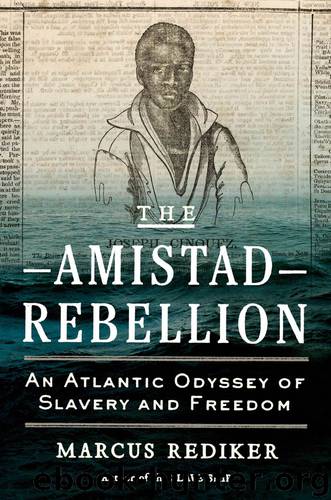The Amistad Rebellion by Marcus Rediker

Author:Marcus Rediker [Rediker, Marcus]
Language: eng
Format: epub
ISBN: 9781101601051
Publisher: Penguin Group US
Published: 2012-11-08T05:00:00+00:00
This radical statement makes clear that not all abolitionists worried about the popular depictions of rebellion; some applauded them. Still, those conducting the defense campaign, who were uncomfortable with depictions of the rebellion, had to decide how to translate their own political commitments into images that would shape the public debate and affect the judgment in court.37
Jocelyn’s Portrait
The abolitionist dilemma of representation was finally resolved by Nathaniel Jocelyn, the best known of the artists who went into the New Haven jail, and the one most firmly connected to the movement. Born in 1796 in New Haven into an artisanal family (his father was a clockmaker and engraver), Jocelyn was apprenticed to a watchmaker but soon took up drawing, engraving, and painting. His sensibilities about slavery were affected by the two years (1820–1822) he spent in Savannah, where he worked as a portrait painter for the Georgia aristocracy. He made his view of the world clear in 1833, when he painted a sympathetic portrait of William Lloyd Garrison, about which, the controversial abolitionist noted, its accuracy would be doubted as it had “no horns about the head.”38
By 1840 Jocelyn had become an active abolitionist, working in the nascent Underground Railroad in Connecticut. His brother Simeon was also a committed abolitionist: he had been the pastor at the predominantly African American church on Temple Street in New Haven, a victim of attack by an anti-abolition mob in 1837, and one of three founding members (with Joshua Leavitt and Lewis Tappan) of the Amistad Committee. Living and working in New Haven, Nathaniel Jocelyn was, like the other artists, close to the epicenter of the struggle. His antislavery views and activism, expressed in his commitment to break the Amistad Africans out of jail by force in January 1840, connected him to the man who commissioned the painting. The African American abolitionist Robert Purvis was a leading member of the Philadelphia Vigilance Committee in 1840 and likewise involved in assisting runaways as they made their way toward freedom. The skilled, radical, and activist Jocelyn was just the man to paint the “official,” soon to become iconic, abolitionist portrait of Cinqué.39
Jocelyn’s painting could hardly have been more different from the images produced by Barber, Moulthrop, and Hewins. Painted during the winter of 1840–1841, the leader is composed, at rest, not on the ship or in jail, but at home in an idealized African environment. The moment appears to be sunset, with gentle clouds and a reddish sky above majestic mountains. Cinqué is not fighting for freedom in an act of slave rebellion; he is free, and has always been free. The artist imagines him in the happy home to which the abolitionists wanted him to return. The entire portrait radiates serenity. The eyes of the leader are not demonic, but rather soft, intelligent, compassionate, liquid. The left hand is relaxed and almost aristocratic in appearance. Jocelyn manages to represent the famous leader of a violent revolt in a way that suggests no violence at all. He
Download
This site does not store any files on its server. We only index and link to content provided by other sites. Please contact the content providers to delete copyright contents if any and email us, we'll remove relevant links or contents immediately.
| Anthropology | Archaeology |
| Philosophy | Politics & Government |
| Social Sciences | Sociology |
| Women's Studies |
Nudge - Improving Decisions about Health, Wealth, and Happiness by Thaler Sunstein(7250)
iGen by Jean M. Twenge(5166)
The Fire Next Time by James Baldwin(5024)
Adulting by Kelly Williams Brown(4238)
The Hacking of the American Mind by Robert H. Lustig(4092)
The Sports Rules Book by Human Kinetics(4079)
The Ethical Slut by Janet W. Hardy(4042)
Captivate by Vanessa Van Edwards(3732)
Mummy Knew by Lisa James(3522)
In a Sunburned Country by Bill Bryson(3374)
The Worm at the Core by Sheldon Solomon(3327)
Ants Among Elephants by Sujatha Gidla(3282)
Suicide: A Study in Sociology by Emile Durkheim(2906)
The Slow Fix: Solve Problems, Work Smarter, and Live Better In a World Addicted to Speed by Carl Honore(2839)
The 48 laws of power by Robert Greene & Joost Elffers(2814)
Humans of New York by Brandon Stanton(2690)
Handbook of Forensic Sociology and Psychology by Stephen J. Morewitz & Mark L. Goldstein(2604)
The Happy Hooker by Xaviera Hollander(2586)
The Tipping Point by Malcolm Gladwell(2563)
